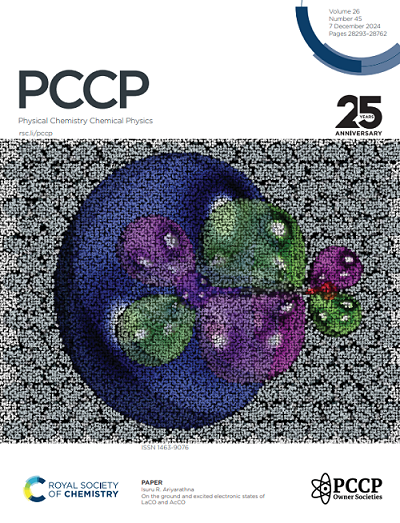Observation of Competing Magnetic Phases, Mechanical Stability, Electronic Structure, Magnetism, and Remarkable Thermoelectric Aspects of the Ba2GdRuO6
IF 2.9
3区 化学
Q3 CHEMISTRY, PHYSICAL
引用次数: 0
Abstract
The Ba2 GdRuO6 (BGRO) double perovskite oxide (DPO) demonstrates intriguing behavior, arising from competing antiferromagnetic (AFM) and ferrimagnetic (FiM) phases. Under the GGA+U+SOC scheme, the system exhibits an AFM ground state with a very small energy difference of −11.39 meV with FiM one. In contrast, spin modeling reveals significant magnetic frustrations along the z-axis and favors the FiM phase. Also, the magnetic phase transition discloses a Curie temperature (T_C) of 60 K. Additionally, magnetization measurements also affirm the FiM nature which lost saturation at higher temperatures, indicating a transition from FiM to paramagnetic above T_C. The electronic structure displays the semiconductor nature owing to a direct energy gap of 1.04/0.89 eV in the AFM/FiM state. The determined spin moments on the Gd(1-2)/Ru(1-2) and Gd(3-4)/Ru(3-4) ions are +6.9/+2.0 µB and −6.9/−2.0 µB in the AFM SO, respectively, while they are +6.89/−2.0 on the Gd(1-4)/Ru(1-4) ion in the FiM one. It is found that, Gd3+ and Ru4+ ions lie in +3(4f ^7) and +4(4d^4) alence state with the electronic configurations of [ fx(x2 −3y2 ) ]↑0 ↓1 [ fy(3x2 −y2 ) ]↑0 ↓1 [ fz(x2 −y2 ) ]↑0 ↓1 [ fxyz ]↑0 ↓1 [ fxz2 ]↑0 ↓1 [ fyz2 ]↑0 ↓1 [ fz3 ]↑0 ↓1 and 3 ↑ t 1 ↓ e0 ↑ e0 ↓ with spin quantum number of 7/2 and 1, correspondingly. Furthermore, the mehanical stability of the material is validated by satisfying the Born stability criteria and the ductility (B/G= 5.19). Noticeably, the presence of a positive Cauchy presis determined by the Pugh’s ratio of 66.53 GPa further supports the ionic nature of the motif. Besides, the system illustrates a positive Seebeck coefficient, indicating holes as the dominant charge carriers with the highest of 279 µV/K at 400 K. Remarkably, system achieves a high figure of merit of 0.86 at 550 K even with the inclusion of lattice thermal conductivity as well as sustaining excellent thermoelectric performance, suggesting a strong potential for elevated temperature energy harvesting applications along with spintronics.Ba2GdRuO6的竞争磁相、机械稳定性、电子结构、磁性和显著热电特性的观察
Ba2 GdRuO6 (BGRO)双钙钛矿氧化物(DPO)表现出有趣的行为,由反铁磁(AFM)和铁磁(FiM)相竞争产生。在GGA+U+SOC方案下,系统呈现AFM基态,与FiM基态的能量差很小,为- 11.39 meV。相比之下,自旋模型揭示了沿z轴的显著磁挫折,并有利于薄膜相。磁相变的居里温度(T_C)为60 K。此外,磁化测量也证实了薄膜的性质,在较高的温度下失去饱和,表明在T_C以上从薄膜到顺磁性的转变。由于在AFM/FiM状态下的直接能隙为1.04/0.89 eV,电子结构显示出半导体性质。在AFM SO中,Gd(1-2)/Ru(1-2)和Gd(3-4)/Ru(3-4)离子的自旋矩分别为+6.9/+2.0µB和−6.9/−2.0µB,而在FiM SO中,Gd(1-4)/Ru(1-4)离子的自旋矩为+6.89/−2.0。发现Gd3+和Ru4+离子处于+3(4f ^7)和+4(4d^4)价态,电子构型为[fx(x2−3y2)]↑0↓1 [fy(3x2−y2)]↑0↓1 [fz(x2−y2)]↑0↓1 [fxyz]↑0↓1 [fxz2]↑0↓1 [fz2]↑0↓1 [fz3]↑0↓1和3↑t↓1↓e0↑e0↓,自旋量子数分别为7/2和1。通过满足Born稳定性准则和延性(B/G= 5.19)验证了材料的力学稳定性。值得注意的是,由Pugh比66.53 GPa决定的正柯西压的存在进一步支持了基序的离子性质。此外,该体系的塞贝克系数为正,表明空穴是主要的载流子,在400 K时最高为279µV/K。值得注意的是,在550 K时,即使包含晶格热导率,系统也能达到0.86的高品质值,并保持优异的热电性能,这表明高温能量收集应用以及自旋电子学具有强大的潜力。
本文章由计算机程序翻译,如有差异,请以英文原文为准。
求助全文
约1分钟内获得全文
求助全文
来源期刊

Physical Chemistry Chemical Physics
化学-物理:原子、分子和化学物理
CiteScore
5.50
自引率
9.10%
发文量
2675
审稿时长
2.0 months
期刊介绍:
Physical Chemistry Chemical Physics (PCCP) is an international journal co-owned by 19 physical chemistry and physics societies from around the world. This journal publishes original, cutting-edge research in physical chemistry, chemical physics and biophysical chemistry. To be suitable for publication in PCCP, articles must include significant innovation and/or insight into physical chemistry; this is the most important criterion that reviewers and Editors will judge against when evaluating submissions.
The journal has a broad scope and welcomes contributions spanning experiment, theory, computation and data science. Topical coverage includes spectroscopy, dynamics, kinetics, statistical mechanics, thermodynamics, electrochemistry, catalysis, surface science, quantum mechanics, quantum computing and machine learning. Interdisciplinary research areas such as polymers and soft matter, materials, nanoscience, energy, surfaces/interfaces, and biophysical chemistry are welcomed if they demonstrate significant innovation and/or insight into physical chemistry. Joined experimental/theoretical studies are particularly appreciated when complementary and based on up-to-date approaches.
 求助内容:
求助内容: 应助结果提醒方式:
应助结果提醒方式:


